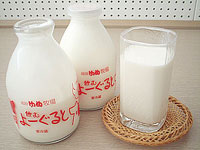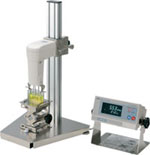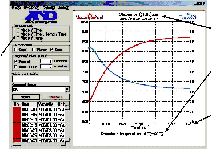SV-10 Application for Yogurt
Reported by Kiyoshi Kono International Marketing Division


Many people like yogurt. It is very good for your health, so patients in hospital eat yoghurt and mothers give it to their children. It is a popular food all over the world.
 Do you have any idea what the viscosity of yogurt is?
Do you have any idea what the viscosity of yogurt is?
Do you remember the properties of yogurt before you mix it and after?
 The yogurt has a characteristic of non-Newtonian fluids that shows different viscosity when a different shear rate is provided. Because of this non-Newtonian fluids, the sample fluid's viscosity is not constant and is therefore difficult to measure.
The yogurt has a characteristic of non-Newtonian fluids that shows different viscosity when a different shear rate is provided. Because of this non-Newtonian fluids, the sample fluid's viscosity is not constant and is therefore difficult to measure.
non-Newtonian fluids
Generally speaking, viscosity is associated only with liquid. Because gas is relatively inviscid fluid, it is considered that no major errors will be produced if ignoring a force towards the direction of the gas flow that exerts on a plane against the gas (tangential stress), unless it is not involving a fast-moving object such as a rocket or aircraft. This kind of ideal fluid in which no tangential stress generates when it is in motion (fluid state) is called a perfect fluid or an inviscid fluid.
Almost all liquid are viscous fluid having viscidity. For example, when rotating a drum container filled with water on its vertical central axis, the water that was at rest in the beginning starts moving as being dragged by the container's inside wall and then whirls completely together with the container as if it were a single rigid body. This is caused by the force (tangential stress) having generated in the direction of the flow (movement) on the surfaces of water and the container's inside wall. A fluid that generates this kind of force is regarded as having viscosity. Viscous fluid is further divided broadly into two categories; Newtonian fluid that is subject to Newton's law of viscosity, and non-Newtonian fluid that is not subject to Newton's law of viscosity.
For the details, please refer to handbook.pdf

 One of the major food companies in Japan , Glico, introduced the SV-10 into their workplace recently, after our Japanese sales people demonstrated how it worked so that they could see and experience for themselves the features of SV-10. At that time, Glico was using the rotational type of viscometers, but because some sample fluids could not be measured by this method they had given up measuring their viscosity. That was before the SV-10 came along.
One of the major food companies in Japan , Glico, introduced the SV-10 into their workplace recently, after our Japanese sales people demonstrated how it worked so that they could see and experience for themselves the features of SV-10. At that time, Glico was using the rotational type of viscometers, but because some sample fluids could not be measured by this method they had given up measuring their viscosity. That was before the SV-10 came along.
 After they had seen our demonstration of SV-10, they requested that we leave the SV-10 at their lab for them to try out for a while. They wanted to see if our claim was correct by trying to measure many samples which could not be measured by the rotational type of viscometer. Just a few days after they had test measured many sample fluids, they placed an order to our dealer. They informed us that they thought the SV-10 was a very interesting viscometer because it can measure viscosity with excellent repeatability, even though the measurement result was different from the result as measured by the rotational type viscometer. They understood that the reason for the difference in the results was because of the shear rate and the characteristic of non-Newtonian fluids.
After they had seen our demonstration of SV-10, they requested that we leave the SV-10 at their lab for them to try out for a while. They wanted to see if our claim was correct by trying to measure many samples which could not be measured by the rotational type of viscometer. Just a few days after they had test measured many sample fluids, they placed an order to our dealer. They informed us that they thought the SV-10 was a very interesting viscometer because it can measure viscosity with excellent repeatability, even though the measurement result was different from the result as measured by the rotational type viscometer. They understood that the reason for the difference in the results was because of the shear rate and the characteristic of non-Newtonian fluids.
 For example, SV-10 measured yogurt's viscosity as 200-300 mPas, although the rotational type method measured the same yogurt as 2000-3000 mPas. The same measurement result was recorded when they measured the same sample yogurt under the usual measuring conditions. However, they found a big difference in viscosity when they filled the same yogurt into the cup for a short time and then for a long time, due to the non-Newtonian fluids characteristic which changes the viscosity. They were happy to know that such differences due to non-Newtonian fluids can be measured by the SV-10.
For example, SV-10 measured yogurt's viscosity as 200-300 mPas, although the rotational type method measured the same yogurt as 2000-3000 mPas. The same measurement result was recorded when they measured the same sample yogurt under the usual measuring conditions. However, they found a big difference in viscosity when they filled the same yogurt into the cup for a short time and then for a long time, due to the non-Newtonian fluids characteristic which changes the viscosity. They were happy to know that such differences due to non-Newtonian fluids can be measured by the SV-10.

 Additionally, Glico bought one more unit of SV-10 after the first unit was delivered because other R&D staff at the company saw the SV-10 in action and were impressed. In particular, they wanted to take advantage of our WinCT-Viscosity software that comes as standard with the SV-10, which relays measurement data to a PC and displays the viscosity and temperature measurement on a time line, greatly facilitating analysis of the data. This made their job easier and gave them the advantage of being able to understand easily the measurement result over time in cases where viscosity and temperature are changing.
Additionally, Glico bought one more unit of SV-10 after the first unit was delivered because other R&D staff at the company saw the SV-10 in action and were impressed. In particular, they wanted to take advantage of our WinCT-Viscosity software that comes as standard with the SV-10, which relays measurement data to a PC and displays the viscosity and temperature measurement on a time line, greatly facilitating analysis of the data. This made their job easier and gave them the advantage of being able to understand easily the measurement result over time in cases where viscosity and temperature are changing.
For our part, we were delighted that our product answered their needs and is helping to develop new products. We are looking forward to eating many more delicious yogurts from Glico in the future!

